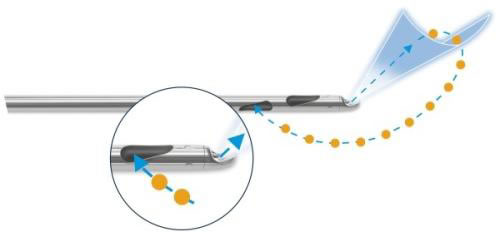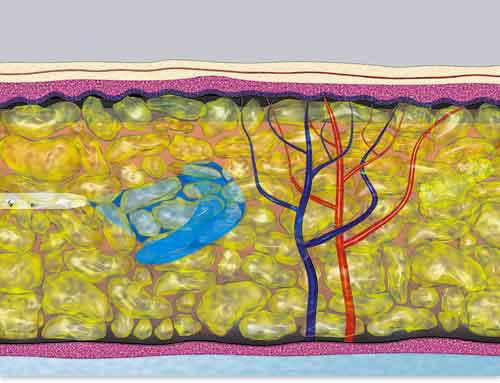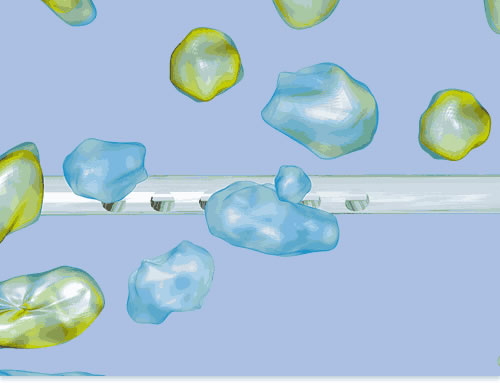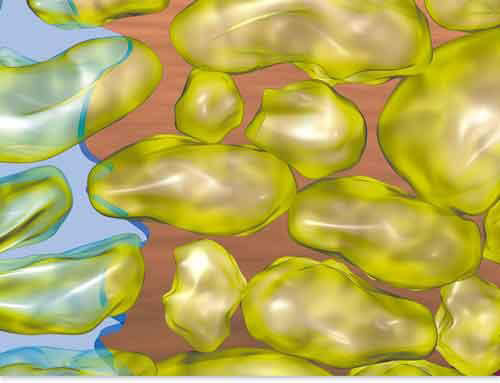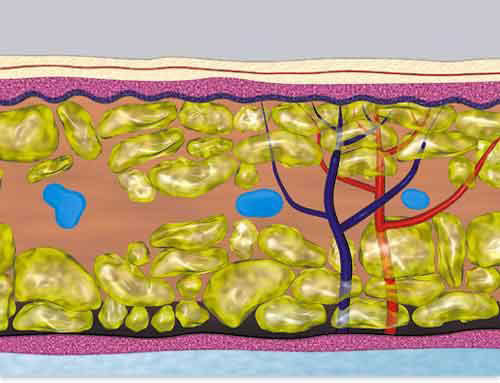Liposoft uses a fine jet of water to gently dislodge fat globules for suction. The smooth pulsed water beam is strong enough to loosen fat for suction but soft enough to spare blood vessels and nerves. By reducing the damage to tissue structures, recovery times and patient discomfort are also reduced.
Since the area is not deformed by swelling, the surgeon can check the natural contours of the body and assess the result throughout the procedure. Working with this level of precision means even the smallest unevenness can be detected, largely reducing the correction procedures that are often required after traditional techniques.
The LipoSoft Procedure
Liposoft uses a specially-shaped cannula to produce a fine, fan-shaped jet of water in front of the cannula.
The pressure of the water-jet gently pushes nerves and blood vessels out of the path of the cannula, minimizing mechanical trauma in the treatment area.
The Liposoft procedure is performed in two phases.
Phase 1: Infiltration
Using the water-jet, the treatment area is infiltrated with a saline solution containing adrenaline (to minimize bleeding) and local anaesthetic. In this phase, the jet is used primarily to distribute the medications.
The small volume of fluid injected produces only moderate swelling of the treatment area, making the procedure more comfortable for the patient.
The water jet permits considerably faster fluid distribution and penetration in the target area, reducing the overall procedure time and the surgeon’s effort. The infiltration phase typically takes 10-15 minutes to complete, depending on the size of the area to be treated.
Phase 2: Contouring
The shape and pressure of the water-jet gently dislodges the fat for suction in a precise manner, giving the surgeon fine control of the contouring process.
Once the infiltration phase is complete, the water-jet is used to dissect the fat for suctioning.
Because the fluid does not distort the treatment area, the surgeon is better able to assess body contours during the procedure. This allows for precise, ‘what-you-see-is-what-you-get’ contouring and thus minimises the need for corrective procedures.
The water is applied directly in the treatment area and then removed with the fat. This minimises the medication load on the patient and also permits the safe treatment of multiple zones within a single procedure.
The suction process continues until the desired shape is achieved. Throughout the process, blood vessels and nerves are displaced by the jet, protecting them from being torn by the cannula.
More than 90% of the injected fluid is removed with the fat, leaving minimal amounts of medication behind and reducing the post-op drainage time to less than 24 hours.
Although Liposoft can be performed under general anesthesia and IV sedation, Liposoft is tailored for (and most commonly practiced under) local anesthesia.
Having the patient conscious throughout the procedure offers several benefits:
- it allows the patient to change position during the procedure, giving the surgeon optimal access to the treatment area;
- it allows the surgeon to progressively check the results with the patient in a standing position;
- the patient can give direct feedback should pain or complications arise;
- risks associated with general anaesthetic are avoided.
Is LipoSoft For Me?
LipoSoft is particularly well suited for women and men who are of relatively normal weight but have fat deposits that make certain areas appear disproportionate. These localised fat deposits may be inherited and typically do not respond to dieting or exercise. LipoSoft is often the only way to eliminate them.
Collections of fatty tissue in any of the following areas may make you a good candidate for LipoSoft:
- Abdomen
- Buttocks
- Outer thighs
- Inner thighs
- Upper arms
- The waist area
- Chin and neck
- Breasts in men
It is important to stress that this technique is in no way of substitute for weight loss or exercise.
Liposoft is not meant to reduce your body size. It is a contouring procedure, and you should not expect it to result in a change of dress size.
LipoSoft is popular among men, particularly for eliminating bulging fat around the waist. It is also very successful in a condition called gynaecomastia in which the male breasts are enlarged.
Although it is possible to have LipoSoft at almost any age, the best results will be obtained if your skin still has enough elasticity to achieve a smooth contour following fat removal. In some older patients where skin is inelastic, it may not re-drape completely and skin excision may be necessary.
The Initial Consultation
During the initial consultation, you will be asked to point out exactly what you would like to see improved. This will help your plastic surgeon to understand your expectations and determine whether they can be realistically achieved.
You will be asked about your medical history, including previous operations, past and present medical conditions, and current medications. It is important that you give your surgeon complete information in order to provide you with the best information and safest options. Medical conditions that may increase surgical risks include high blood pressure, thyroid problems, diabetes, and bleeding problems.
Your weight and your plans to lose or gain weight in the future will be factors in evaluating you for LipoSoft. Your plastic surgeon may ask you about the effects of prior weight loss on the appearance of those areas that you have indicated contouring. He will also assess the elasticity of your skin and judge whether any skin needs to be removed.
Usually, photographs will be taken for preoperative planning and for documentation.
Preparation For LipoSoft
Smokers need to stop smoking 3 weeks before surgery. Aspirin and some anti-inflammatory drugs can cause increased bleeding, so you should avoid taking these medications for 2 weeks before surgery. LipoSoft is usually performed on an outpatient basis. If this is the case, make certain you have someone to drive you home after surgery and to stay with you for the first night after surgery.
In most cases, the operation is performed under intravenous sedation or local anaesthetic. It is therefore very important that you do not have anything to eat or drink at least six hours before your operation.
The Day of Your Procedure
Your procedure is usually performed in a day surgery facility.
Your surgeon will mark out the areas to be treated and if this has not been done already, photographs will be taken.
Medications are administered for your comfort during the surgical procedure.
Various monitors are used to check your heart, blood pressure, pulse and the amount of oxygen circulating in your blood.
Your Procedure
Because of individual factors, not everyone will achieve the same results from LipoSoft.
The surgeon will have determined the site of incisions through which he can best perform the LipoSoft. Small incisions, approximately 1 cm long are then made and the suction canulas are introduced through them.
When the surgeon has judged that the appropriate amount of fat has been removed, the incisions are sutured.
How Long Does The Procedure Take?
The operation takes 1 to 3 hours, depending on the extent of each procedure.
Recuperation And Recovery
When surgery is completed, you will be taken into a recovery area where you will continue to be monitored.
There may be some discomfort for several days after the operation, although this is usually not severe. Oral pain medications are usually sufficient to control the discomfort. You will be advised to rest for 24 to 72 hours. It is also possible to experience some numbness in the skin overlying the treated area but this usually disappears in a few months.
You will be asked to get out of bed as soon as possible after the operation. It is also important not to take aspirin or to smoke for 3 weeks after the procedure.
It is very important for a supportive dressing to be worn after surgery. A commercially made support garment is worn immediately after surgery. The garment needs to be worn for about four weeks after surgery.
It is important to realise that recovery time varies greatly among individuals.
You may have stitches along the incisions, which will be removed at four to seven days. Bruising and swelling can last up to 2 weeks or longer in some cases.
Results of Your Procedure
Since the healing process is gradual, you should expect to wait at least 6 weeks to get an accurate picture of the results of your operation. Incisions will fade over several months.
When Can I Resume My Normal Activities?
Walking and normal daily activities should be possible very soon after surgery. You should be able to return to work in just a few days. In most cases, you should be able to resume most of your normal activities within several weeks.
Risks and Possible Complications
The subject of risks and potential complications of surgery is best discussed on a personal basis between you and your plastic surgeon.
- Irregular contours are the commonest problem seen after LipoSoft.
- Postoperative bleeding, which can result in a collection of blood is rare, but may necessitate return to the operating theatre for evacuation.
- Blood clots in the leg veins are an uncommon complication but may be serious due to the risk of blood clots travelling to the lungs.
- An area of skin loss is an extremely rare complication but has been reported in surgical literature.
- Infection can also occur and depending on severity, antibiotics by mouth or intravenously may be prescribed.
- Skin burns can be seen with the use of ultrasound probes although these are very uncommon with modern instrumentation.
You can help to minimise certain risks by following the advice and instructions of your plastic surgeon, both before and after your surgery.
Keeping In Touch
If you have any questions about LipoSoft, be sure they are answered in advance. Well-meaning friends are not a good source of information. Find out everything before proceeding with the operation—a well-informed patient is a happy one.
After surgery, you will return to your plastic surgeon’s office for follow-up care at prescribed intervals, at which time your progress can be evaluated. Once the immediate postoperative follow-up is complete, many surgeons encourage their patients to come back for periodic check-ups to observe and discuss the long-term results of surgery.
Please remember that the relationship with your plastic surgeon does not end when you leave the operating room. If you have questions or concerns during your recovery, or need additional information at a later time, you should contact your surgeon.

